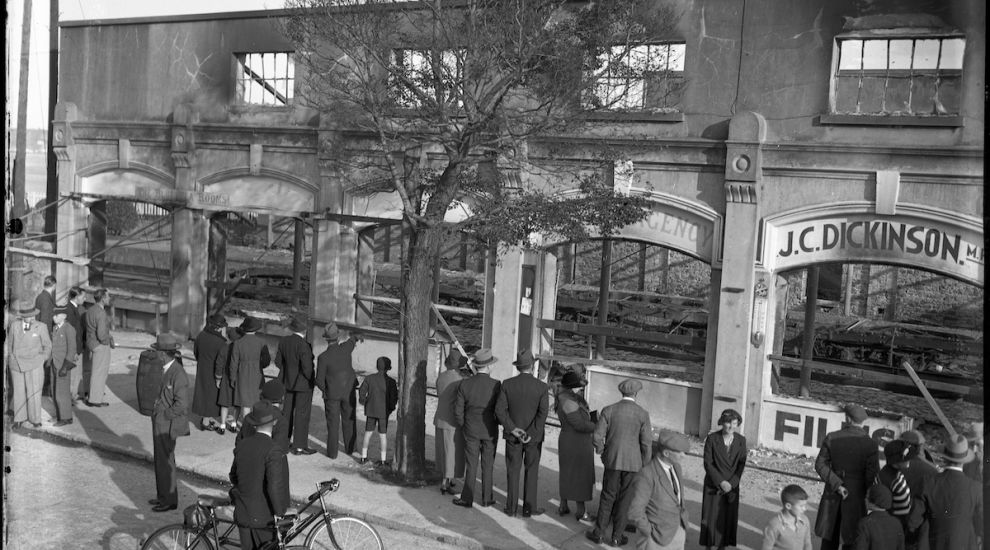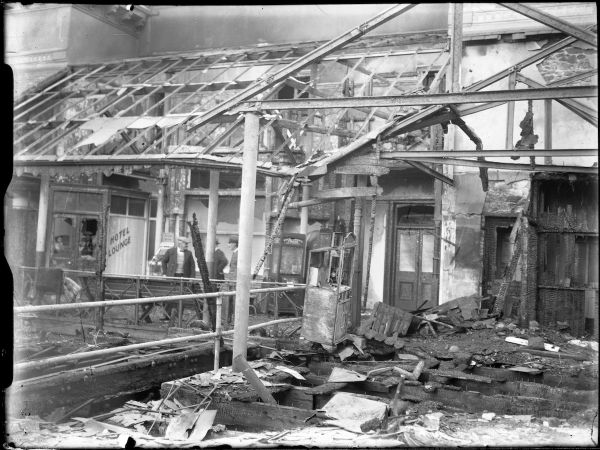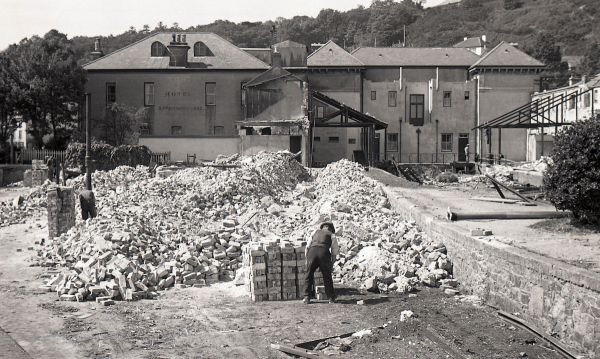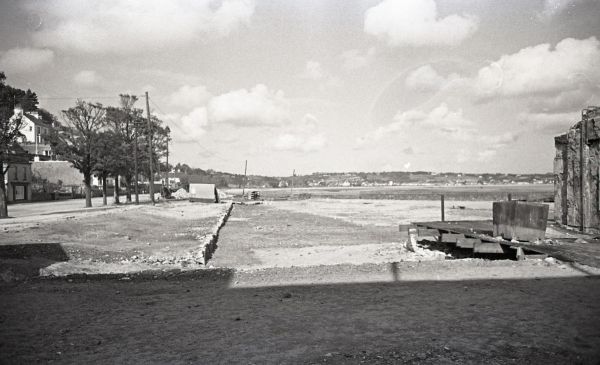


Almost 90 years ago, residents in St. Aubin woke up in the middle of the night to discover one of the worst fires Jersey had ever seen out ripping through part of their village.
The devastating incident took hold in the early hours of 18 December 1936 and was later described as causing “an orgy of destruction”, with flames so bright it seemed like daytime.
It destroyed the St. Aubin Railway Station, five roadside shops, 15 railway coaches and trolleys, as well six rooms in the Terminus Hotel Annexe, which ran down the length of the west-side of the station. A room and a balcony in the main hotel building next door were also destroyed.
The blaze was fanned by a strong north-westerly wind and it took all the energy of the fire brigade to stop it spreading further.
The fire started in one of the shops attached to the station and facing St. Aubin’s Road. Mr Chapman, an employee of the Jersey Electricity Company, was first on the scene. He was returning to his house at Ouaisné on his bike at 1.30am when he noticed flames in the butcher’s shop tenanted by Mr Walters.

Pictured: Islanders look at the St. Aubin fire site in 1936.
Mr Chapman broke the window and went towards the fire but quickly realised he had no means to extinguish the blaze and retreated to find help. He attempted to open the station doors to reach the public telephone but found them locked. He then went to the Terminus Hotel next door, where St. Brelade’s Parish Hall is now situated, and rang the bell twice.
Unfortunately, Mr Forgeard, the proprietor, assumed it was someone playing a prank and ignored it.
Mr Chapman ran to St. Aubin’s Dairy where he managed to break down the door, much to the occupant, Mrs Amy’s, surprise. She called the fire brigade whilst Chapman returned to the scene.
This had taken 15 minutes and the fire had now taken hold. The shops were partitioned with wood, which meant the flames spread quickly. Mr Chapman was joined by Mr Gautier, the café proprietor, and Mr Prue, the estate agent, and together they tried to remove valuables from some of the shops.

Pictured: The destruction caused by the St. Aubin fire in 1936.
Mr Chapman later told the Evening Post that the rumour the fire was started by the electricity supply was false as the supply to Mr Walters’ shop had been cut 12 months previously and that in any case, the flames he had initially seen were on the opposite side to any electrical wires. This was confirmed by the Jersey Electricity Company.
Mr Walters was at a loss as to the cause of the fire. He had only been married a fortnight and was in severe shock when he heard his business had been destroyed. In the days that followed, it was suggested that it may have been burglars who started the fire but this was never confirmed.
Back to the night of the fire and the manager of the Terminus Hotel was eventually roused to
action.
Having initially ignored the ringing of the bell, Mr Forgeard later heard shouts, the sound of breaking glass and the smell of smoke and went to investigate. Going out into the hallway, he found it full of smoke. He woke up his family and guests and they began to escape in the dark until neighbours came to their assistance with torches.

Pictured: Inside the St. Aubin railway station after the fire in 1936.
In reports of the fire, Mrs Forgeard said: “It was a blessing everyone got out safely. The children were all rescued without trouble, but my son, who was sleeping on the balcony, lost all his clothes. My daughter-in-law made her escape by way of the balcony and out of the passage by another window, as she was caught in the smoke.
One of my daughters cut her leg in kicking a window open, but otherwise no one was hurt.”
The waiter, Mr Kaynes, played a key part in evacuating the staff members, waking the cook, the boot (servant boy) and maids. He went back in to try and save his clothes but had to escape with only what was left on his bedrail as the flames moved closer.

Pictured: Demolition of fire site in June 1938.
He said about the Annexe to the hotel: “That corridor in the wing was 100 feet long, we measured it the other day and there were seven rooms along it. Now there is only half a room left, all the rest has gone.”
When the fire brigade arrived on the scene, Chief Officer Remphry had a difficult decision to make. He decided there was nothing that could be done for the station or the shops and the prime objective had to be to save the main hotel building. The firefighters concentrated their resources on trying to stop the fire moving further and after several hours, this proved successful.
The Evening Post reported on the ferocity of the fire. Spectators who saw it from St. Helier described it as being “like a huge firework display, as the flames rose and fell in their orgy of destruction and the sparks were carried into the air by the wind”.
A resident of the High Street in St. Aubin said: “The glare was so bright that despite the screen of houses overlooking the station, it was light enough to pick flowers in the garden, while round the station itself the fire made the scene as light as day.”

Pictured: Sept-Oct 1938 - fire site cleared.
Reports also told of criticism of the fire brigade but that they were convinced they had done all they could and that concentrating on saving the main hotel was the correct decision. They also noted that the fire brigade was entirely voluntary and small in number.
Incredibly, there were no casualties. Within this scene of utter devastation, there was a fountain at the hotel end of the station platform that contained a number of goldfish. Despite the intense heat and chaos, even the goldfish managed to survive and could be seen swimming around contentedly as people came to survey the site of the fire the following day.
The railway, already in a downward spiral as a result of the advent of the age of motor cars and buses, never truly recovered. In November, the company wrote to the Main Roads Committee offering to sell the real estate and concessions to the States, which the Committee agreed to.
The contract was passed in December 1937 and included the station at St. Aubin and adjacent Terminus Hotel. The hotel became almost derelict and was sold to the Parish of St. Brelade in 1946 before the decision to build the Parish Hall there was made the following year.
This story was told as part of a series in collaboration with Jersey Heritage.
To uncover more stories like this, visit Jersey Archive or search its online catalogue HERE.
Customs in-fighting leads to campaign for justice after job loss
How a fantastic pianist Prince became Jersey 'alien'
RAF pilot stops at Jersey petrol station to refuel plane
Fishermen rescue serial thief in stolen boat
‘Disgraceful’ Christmas fracas at one of Jersey's most exclusive clubs
Socialite gets death threat from ‘Jacques’ the Ripper
‘Troglodyte Caves’ draw crowds to Five Oaks
Comments
Comments on this story express the views of the commentator only, not Bailiwick Publishing. We are unable to guarantee the accuracy of any of those comments.